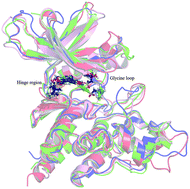Enhancing specificity in the Janus kinases: a study on the thienopyridine JAK2 selective mechanism combined molecular dynamics simulation†
Abstract
The selective inhibition for JAK2 over the other JAK family kinases (JAK1, JAK3 and TYK2) has shared an immense challenge due to high conservatism. In this paper, the highly JAK2 selective mechanism of the thienopyridine derivative 19 was identified at the molecular level, based on insights into the inhibitory effects of compound 19 on four JAK kinases by molecular docking, molecular dynamic simulations, free energy calculation and decomposition. The results clearly indicated that the nonpolar contribution and the H-bond network in the hinge region played a critical selective role in stabilizing ligand JAK2, and the residues Glu930, Leu932 and Gly935 in JAK2 kinase were the key differences compared to the equivalence residues of JAK1, JAK3 and TYK2, which were further verified by simulating four complexes of JAK kinases with another highly selective thienopyridine JAK2 inhibitor 22. Finally, several novel molecules were designed according to above findings and further verified by the same comprehensive modeling protocol. The obtained results not only demonstrated the rationality of our models and analyses, but also suggested that the designed molecules with higher JAK2 selectivity and bioactivity potential would provide an update of JAK2 inhibitors.


 Please wait while we load your content...
Please wait while we load your content...